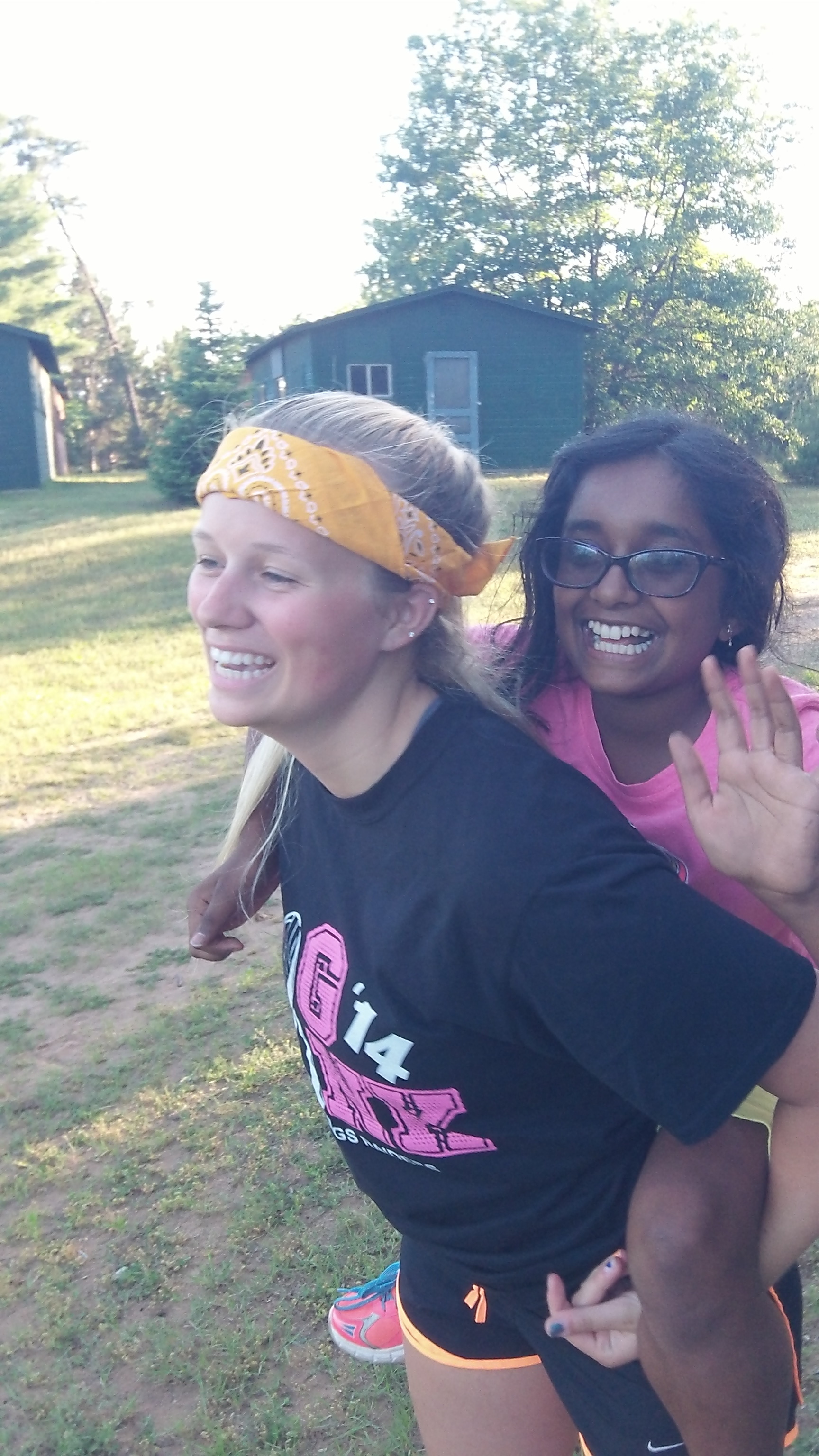 As a camp director in the camping industry for nearly 1/2 of my life I constantly ask my self what are the positive benefits we provide to children. Oh sure, we play out side and are away from technology and that is all good but thier must be more. At Swift Nature Camp we focus on nature and science studies so I have always believed that when children come together with a common interest like animals they build greater bonds. Kinda like a sports team for those kids who are not sportsy. A few years back I had the pleasure to meet Niambi and hear about the specail work she was doing at her summer camp. It was at that point that it became clear that all camps help build acceptance of others and a closeness between cultures. Below is a recent article she wrote concerning the impact summer camp can have on all of society.
As a camp director in the camping industry for nearly 1/2 of my life I constantly ask my self what are the positive benefits we provide to children. Oh sure, we play out side and are away from technology and that is all good but thier must be more. At Swift Nature Camp we focus on nature and science studies so I have always believed that when children come together with a common interest like animals they build greater bonds. Kinda like a sports team for those kids who are not sportsy. A few years back I had the pleasure to meet Niambi and hear about the specail work she was doing at her summer camp. It was at that point that it became clear that all camps help build acceptance of others and a closeness between cultures. Below is a recent article she wrote concerning the impact summer camp can have on all of society.
Fear Interrupted: Reframing Cross-Cultural Narratives at Camp
Several years ago, when I directed my camp program specifically for African- American teen girls (Camp Butterfly), there were many memorable moments.
But one in particular has been etched in the recesses of my mind since the day it occurred. The event happened during one of our summer sessions; it involved a young 13-year-old girl named “Lea.”
During the day, Lea got along with all the other girls, was outgoing, and seemed pretty typical on the surface. But every night she would wreak havoc in the cabin. She picked fights with the other girls, was disrespectful to her counselors, and refused to go to bed. At first glance, it appeared that she suffered from some nocturnal Dr. Jekyll and Mr. Hyde syndrome. As we gained her trust, we were able to uncover the truth. Lea was afraid to go to sleep because nighttime had proven to be the most unsafe time for her. She had been in a foster home where her bed was positioned right next to the bedroom door. This made it easy for her older foster brother to silently enter the room at night, undetected by her sleeping younger sister. He would kneel by the side of her bed and sexually violate her. We learned that this had been a nightly ritual for almost three months when she was 11 years old until she and her sister were reassigned to a different foster home due to other circumstances. She had never shared the truth of her horrific past and wasn’t even consciously aware of its effects on her nighttime behavior. At camp, her assigned bed was close to a door. She complied during the day but was terrified at night. She picked arguments with the other girls to keep the lights on.
Fortunately, she had a close-knit group of girls and counselors in her cabin. Lea was finally able to share the stories of her past, and, as a group, they focused not on her behavior but on what was driving it. Because she was in a cabin (and camp) with other girls who looked like her, her nightly terror and verbal assaults on the other girls and staff were not deemed to be racially motivated. But I have to be honest, I often wonder if she had been in a cabin where she was the only black girl, would her behavior have been associated with the color of her skin?
I have consulted with camps which, in their efforts to become more diverse, recruit black youth and counselors, dispersing them among different groups within the campus to diversify the camp experience. When incidents or misunderstandings occur, it is effortless to hit our internal default buttons and view them through a black-and-white lens. For many white youths (and counselors), camp may be the first time they have been in a social/ work setting with blacks and vice versa. If Lea had been in a cabin with primarily white girls, and potentially the only person of color, I can only imagine the stories that might have been created around the incident. Given past societal experiences, Lea might have been sent home for being a “disruptive black girl” if she didn’t have staff available with whom she felt safe to explore the truth and who could see beyond the color of her skin. Her loud, aggressive behavior at night could have been deemed “typical” in the minds of counselors and campers who had no prior social connections with black people outside of camp. The unconscious lens of prejudice and implicit bias could have become a considerable barrier to complete acceptance, empathy, and compassion for Lea.
With all the injustice and racially motivated discord that continues to happen in the world, every story we hear, witness, participate in, or create, we shape through our own pain and projection — or through our real power and sense of possibility. Camp creates a beautiful refuge from the distractions of the outside world and has the potential to reconnect us with our inner worlds through nature. The challenge is we bring our stories with us. We carry them in our hands, in our minds, in our feet, and in our hearts. Like tiny fibers, each coded piece of data is like a letter; together they form words and sentences about who we are. Those sentences are then strung together to form paragraphs and then whole stories of who we are — or more accurately — who we think we are (and who we think others are as a result). Sometimes those stories play over and over in our heads like song lyrics. And I suppose, when we feel safe, we speak our stories out loud so that we can sort them all out — and then be open to really hearing others’ stories.
How can we short-circuit our thoughts and bypass the stories we carry about others that are based on fears and often lead to generalizations about entire cultural groups?
- Make sure your social circles outside of camp include people from diverse cultures and backgrounds. We are less likely to see the behavior and actions of one individual as a representation of an entire group if we have formed meaningful relationships with people from a variety of ethnic and cultural groups outside of camp. Without those meaningful relationships, it is easy to unconsciously fall prey to seeing them through the lens of stereotypical assumptions rather than their true personalities.
- Be intentional. Racism is real. We have all been affected by its influence. It is embedded in our psyches, whether we are conscious of it or not. Color is the first thing we see, and some never get past it in creating meaningful relationships. However, we can’t act as if those cultural markers don’t exist. We must see color and then intentionally cultivate relationships that move beyond it. When we do, we can collectively experience aspects of our humanity that extend far beyond our ethnic groupings and can bind us together heart and soul. When we see each other only through the lens of our external colors and cultural representations, we miss out on opportunities for more in-depth understanding, compassion, and empathy for one another.
- Invest in diversity, equity, and heart-centered inclusion work — both at camp and beyond. Racism poses a continual assault on our senses. It is designed to divide us, and we all carry unconscious bias, blind spots, and pain triggers. It is our job to heal those ancestral footprints that are deep inside of us. We can’t transform what we are unwilling to see and feel. So we must look honestly at our biases and prejudices. They can be invisible walls that prevent our campers and counselors from showing their authentic selves. Or they can become bridges that encourage their authentic selves to be on full display.
- Be vulnerable and brave. If you find yourself in a situation where a counselor or camper is from a different culture or ethnicity than you and their default setting is stuck on some painful memory, trauma, sadness, or fear — causing destructive behavior — what do you do? Use your camp wisdom. Don’t allow their current attitude to become a culturally stereotyping story in your mind. Face it with compassion. See the humanity in the individual. Whether you are able to figure out what is causing the underlying pain or not, listen, empathize, and perhaps offer a different perspective. You likely will build bridges, create smiles, and lift spirits. In my experience, each time I open my heart and soul to someone who doesn’t mimic my perspective, my heart expands.
Lea doesn’t represent every black girl’s experience in our society. Unfortunately, sexual assault is something experienced by many young people across cultures. It doesn’t by any means define the person, but it is part of far too many of their stories. When their behavior isn’t perfect, it is easy to view others through the lens of our implicit biases. When we become aware of our own stories and triggers, we can interrupt the patterns of separation and fear. As we bind ourselves together heart to heart, we create an opportunity to reframe the stories we tell ourselves about different cultural groups. We then see and experience our humanity together.
It is when we can disrupt our patterns of thinking and disassemble the stories within us that camp actualizes the collective vision of many: to be a safe place to enrich the lives of children and adults. But we can’t get there if we are too afraid to tell each other the truth and see each person as an individual with a rich culture, and not a representative of their entire cultural group.
Camp has an opportunity to assist the world in writing a new narrative. The only way for us to truly break down our cultural barriers is for us to be in relationship with each other — even when doing so is complicated.
Cultural aha moments at camp often live beyond the summer. While the shine of overcoming fear and bias experienced at camp may be tested when a camper or counselor is back in the real world, they will remember their camp stories — where they felt loved, accepted, and respected. Those stories of your compassion will feed the flames of change. When people from different cultures interact, we can always learn something valuable. We see that we are connected, that our fates are bound together. We are all part of one tribe. The Human Tribe. Together, let’s interrupt the fear and create some new stories across cultural lines.










